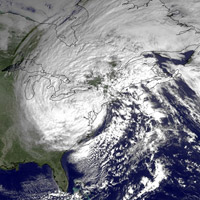
| Sandy | 2 November 12 |

A forecasting firm, IHS Global Insight has indicated the Superstorm Sandy, will likely end up costing $20 billion in damages and anywhere from $10 billion to $30 billion in lost business. Sandy's path has sparked speculation regarding the effect of melting arctic sea ice on weather patterns. Jeff Masters, the co-founder and director of meteorology at Weather Underground, speculated, "There is evidence that Arctic sea ice loss might be responsible..." Masters said. "Our sea ice losses are a relatively new phenomenon, and we don't have a lot of years of data to study. But there certainly is a lot of potential for climate change to affect a storm like this." The potential of climate change to affect weather patterns hit home hard for the millions of people just starting to recover from Sandy's landfall on the Eastern coast of the united States. View November 2, 2012 Huffington Post blog postView November 1, 2012 The New York Times article View October 30, 2012 BBC News article View October 30, 2012 CBC News article View October 30, 2012 Huffington Post article |
|
 Print version Print version |
Top |
